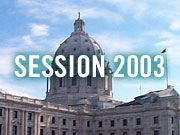Audio
More from MPR
Your Voice
| |||||||||||||||||||||||||||||||||||||||||||||||
Iron Range cities feeling singled out
June 5, 2003
Cities and towns across Minnesota will be getting less money from the state in coming years. The Legislature cut aid to cities to help balance the state budget. But cities on the Iron Range say they're getting a double dose of cuts from the Legislature, just when the Range is facing more mine closures. But lawmakers and the Pawlenty administration say the Iron Range has been getting more aid than it deserves for years.
Duluth, Minn. — The dispute centers on an abstract mathematical formula, but it's a very real argument. Millions and millions of dollars are on the line.
The state of Minnesota gives money to cities. It's called local government aid -- LGA. The state looks at two things to figure out how much LGA a city gets: first, how needy is the city; and second, how much money can the city reasonably raise through local property taxes. Cities with high need and low property values got more LGA. Beginning this year, the state is giving out less LGA money. That means cities all over the state have to cut their budgets.
Up on the Iron Range, there's an extra wrinkle to the story.
Cities on the Range also get taconite aid. Mining companies pay taxes on what they dig out of the ground. On the Iron Range, that money doesn't go to the state. It gets distributed to cities, counties, and school districts in northeastern Minnesota.
|
It treats every city equally. It's not like we've singled out the Iron Range for special treatment.
- Dan Salomone, Minnesota Commissioner of Revenue |
The state didn't used to count the taconite aid when it figured out how much LGA to give to cities on the Range. Now the state legislature has a new way of looking at that taconite money. Starting next year, the state will include the taconite money. That means cities on the Iron Range will lose even more state money than other cities in Minnesota.
"We're in a Catch 22 here," says Ron Lackner, the finance director for the city of Virginia. "Where we're going to go, I'm not sure yet." Next year, Virginia is losing about 11 percent of its $10 million budget because of LGA cuts. The average loss for Minnesota cities is about five percent. Lackner says Virginia is already making cuts.
"We're cutting library hours," Lackner says. "We've cut personnel there. We haven't hired replacement firefighters, policemen, and public works employees." But that's only the beginning of the story for the city of Virginia.
Two years from now, the state will start counting taconite money against the city's LGA. When the new formula kicks in, Virginia will lose one-fourth of its entire budget. Lackner says he doesn't know how the city can cut that much. And some cities on the Iron Range will face even bigger cuts.
State legislators and people in the governor's office say they're not picking on the Iron Range. Dan Salomone is the state's Revenue Commissioner.
"Historically, they have in a sense gotten a better deal than other cities," Salomone says.
He says cities on the Iron Range have been getting taconite aid and money from the state, and that's unfair. Salomone says the new LGA formula does a better job of balancing a city's needs against how much money the city can raise.
"It treats every city equally," he says. "It's not like we've singled out the Iron Range for special treatment."
Some city officials are making the cuts sound worse than they are, Salomone says. Cities are allowed to raise their property taxes to replace most of the state money they lose.
But Sen. David Tomassoni, DFL-Chisholm says that doesn't make sense. He says the cities that are losing the most money in state aid are the poorest cities; the places with the lowest property values.
"And the property taxes that they would raise would not even come close to the relief that lost," Tomassoni says. "People would see huge property tax increases and see very, very little of the service cuts replaced."
The cuts in state money are hitting cities on the Iron Range at a tough time. About 500 workers lost their jobs when the EVTAC mine closed in May. Across the Range, thousands of mine workers have been laid off in the past few years.
Sen. David Tomassoni says next year lawmakers from the Iron Range will try to change the formula for determining state aid to cities. He wants smaller cuts in rural Minnesota, and bigger cuts in the suburbs.
|
News Headlines
|
Related Subjects
|

